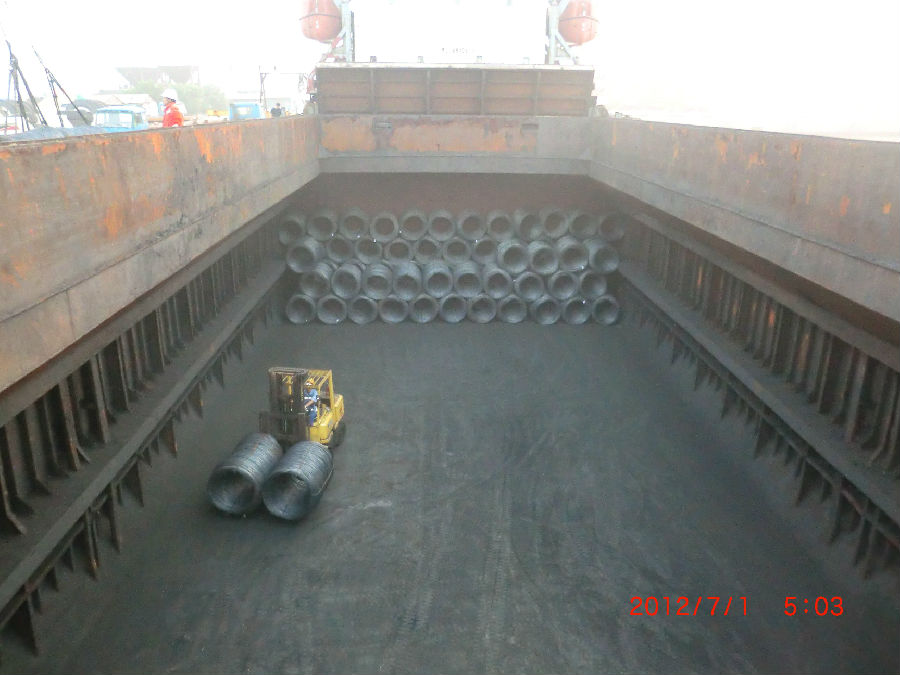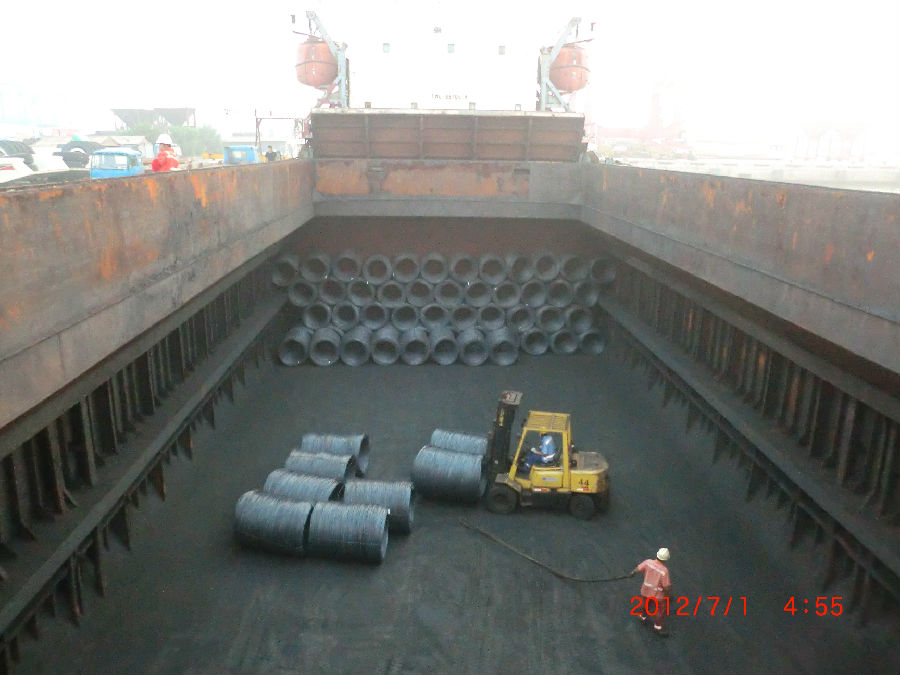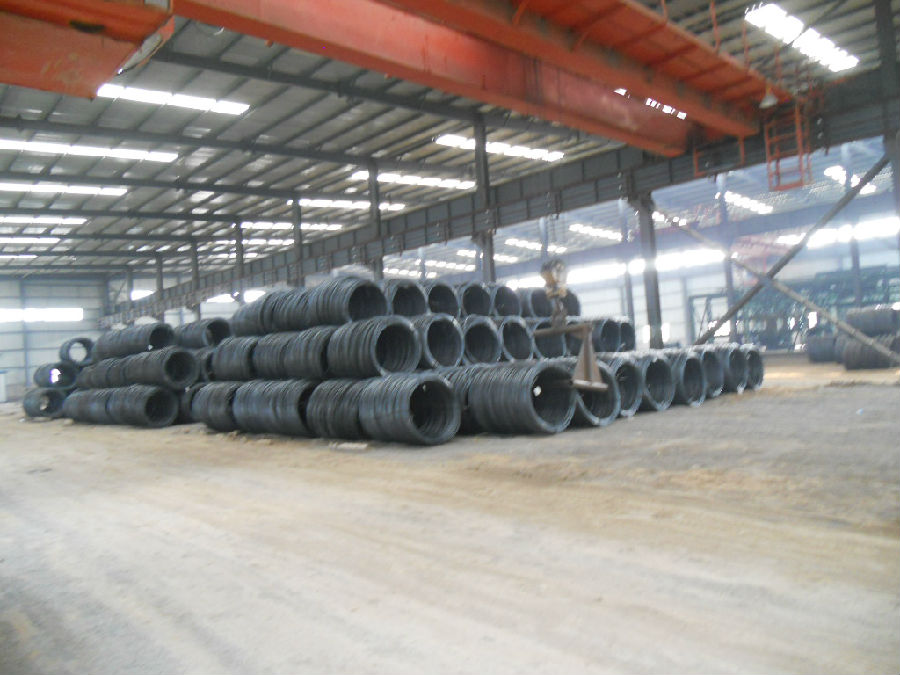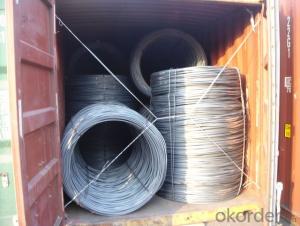steel wire rope price SAE1008 100 Metric Ton
- Loading Port:
- Tianjin
- Payment Terms:
- TT OR LC
- Min Order Qty:
- 20 m.t.
- Supply Capability:
- 18000 m.t./month
OKorder Service Pledge
OKorder Financial Service
You Might Also Like
Specifications
steel wire rope price
1)Grade:Q195/235,SAE1010,SAE1008,SAE1018B
2)Dia:5.5-14mm
3)Moq: 100 tons
4)Proce:FOB520-575usd/ton
steel wire rope price SAE1008
1.Diameter: 5.5mm-14mm
2.Material:Q195-235; SAE1008-SAE1018
3.surface:round,no twisted,light and smooth
4.Coil weight:1.8-2.1ton
5. Measurement of Weight: By Actual Weighting
6.Coil OD:1.1M
7.Applicant: wire drawing,welding electrode, nail
8.Payment term: TT or L/C at sight
Please kindly find our chemistry of our material based on SAE1006B and SAE1008B as below for
your information:
Grade | Chemical Composition(%) | |||||
C | Mn | Si | S | P | B | |
SAE1006B | 0.03~O.07 | ≤0.32 | ≤0.30 | ≤0.045 | ≤0.040 | >0.0008 |
Mechanical properties | ||||||
Yield strength(N/mm2) | Tensile strength(N/mm2) | Elongation(%) | ||||
250-280 | 350-380 | ≥32 | ||||
Grade | Chemical Composition(%) | |||||
C | Mn | Si | S | P | B | |
SAE1008B | 0.10max | 0.3~O.50 | 0.15max | 0.050max | 0.040 max | 0.0008 min |
Mechanical properties | ||||||
Yield strength(N/mm2) | Tensile strength(N/mm2) | Elongation(%) | ||||
≥195 | 315-430 | ≥30 | ||||



- Q:What are the safety considerations when handling steel wire rods?
- Some safety considerations when handling steel wire rods include wearing appropriate personal protective equipment such as gloves and safety glasses to protect against cuts and eye injuries. It is also important to handle the rods with care to avoid dropping or mishandling them, as they can cause injury or damage if they fall or swing. Additionally, workers should be cautious of sharp edges or protrusions on the rods and avoid placing themselves in positions where they may be struck or pinched.
- Q:How are steel wire rods used in the automotive industry?
- Steel wire rods are commonly used in the automotive industry for various applications such as reinforcement in tires, suspension systems, seat belts, and springs. These rods, due to their high strength and durability, help enhance the overall safety and performance of vehicles.
- Q:How does the brittleness of steel wire rod vary with different wire drawing processes?
- Different wire drawing processes can result in varying brittleness of steel wire rod. Wire drawing involves reducing the wire's diameter by pulling it through dies. The specific process used has a significant impact on the wire's final properties, including brittleness. One factor affecting brittleness is the reduction in area during wire drawing. This refers to the amount of material removed as the wire passes through the dies. Higher reductions in area lead to more deformation and strain, increasing brittleness. This occurs because the steel's grain structure becomes elongated and aligned, making it more prone to cracking and breaking under stress. Another influence on brittleness is the drawing speed. Higher speeds create greater strain and deformation, increasing brittleness. Rapid cooling during drawing can also contribute to brittleness by promoting the formation of brittle phases in the steel structure. The heat treatment applied after drawing can also impact brittleness. Processes like annealing can relieve internal stresses and improve wire ductility, reducing brittleness. Conversely, improper heat treatment or inadequate cooling can increase brittleness. To achieve desired mechanical properties, manufacturers must carefully control factors such as reduction in area, drawing speed, cooling rate, and heat treatment. By doing so, they can ensure the desired brittleness of the steel wire rod.
- Q:What are the physical properties of steel wire rod?
- Steel wire rod has several physical properties that make it suitable for various applications. Firstly, it has high tensile strength, which allows it to withstand heavy loads and resist deformation. This property makes it ideal for use in construction, manufacturing, and engineering industries. Additionally, steel wire rod exhibits excellent ductility, meaning it can be easily bent or twisted without breaking. This flexibility makes it suitable for applications that require shaping or forming, such as in the production of wire products. Furthermore, steel wire rod possesses good thermal conductivity, allowing it to efficiently transfer heat. This property makes it useful in applications such as heating elements or electrical conductors. Lastly, steel wire rod is corrosion-resistant, which ensures its longevity and durability in various environmental conditions. Overall, the physical properties of steel wire rod make it a versatile and reliable material for a wide range of applications.
- Q:What are the different types of steel wire rod coatings used for enhanced wear resistance?
- To enhance wear resistance, steel wire rods commonly utilize different types of coatings. These coatings are applied to the surface of the wire rod, providing a protective layer that improves durability and longevity. One method for enhancing wear resistance is through the use of zinc coatings. Known as galvanizing, this process involves immersing the steel wire rod in molten zinc. As a result, a layer of zinc forms on the wire's surface, acting as a barrier against corrosion and wear. Zinc coatings are often used in environments with harsh conditions or high levels of moisture. Another approach to wear resistance is the application of polymer coatings. Typically, these coatings are a thin layer placed on the surface of the steel wire rod. They create a protective barrier against abrasion, chemicals, and other forms of wear. Polymer coatings can be customized to possess specific properties, such as resistance to high temperatures, low friction, or specific chemicals. Consequently, they are suitable for a wide range of applications. Additionally, ceramic coatings are employed to enhance wear resistance in steel wire rods. The application of ceramic coatings is typically achieved through a chemical or physical vapor deposition process. These coatings create a thin layer of ceramic material on the wire rod's surface, offering excellent resistance to wear, corrosion, and high temperatures. Ceramic coatings are commonly used in scenarios involving extreme conditions or high levels of friction. In conclusion, there are several types of steel wire rod coatings used to enhance wear resistance. Zinc coatings provide protection against corrosion, polymer coatings offer resistance to abrasion and chemicals, and ceramic coatings excel in resistance to wear, corrosion, and high temperatures. The choice of coating depends on the specific application and the desired level of wear resistance required.
- Q:What are the main factors affecting the dimensional stability of steel wire rod?
- The main factors affecting the dimensional stability of steel wire rod are the composition of the steel, the cooling rate during the manufacturing process, and the level of residual stresses present in the wire rod.
- Q:What are the common surface defects in steel wire rod?
- Some common surface defects in steel wire rods include scale, surface cracks, surface depressions, scratches, and rust spots.
- Q:What are the safety considerations when handling steel wire rod?
- Some safety considerations when handling steel wire rod include wearing protective gloves and eyewear to prevent cuts and potential eye injuries. It is also important to use proper lifting techniques and equipment to avoid strains or back injuries. Additionally, individuals should be cautious of sharp edges and ensure that the wire rod is stored and transported in a secure manner to prevent accidents or damage.
- Q:What are the main factors influencing the choice of steel wire rod storage conditions?
- The main factors influencing the choice of steel wire rod storage conditions include the type and quality of the wire rod, the desired shelf life, the environmental conditions, and the specific requirements of the end-use application.
- Q:What are the different mechanical testing methods used for steel wire rod?
- There are several mechanical testing methods that are commonly used for steel wire rod in order to assess its quality and performance. These methods include: 1. Tensile testing: This is the most common and fundamental mechanical test for steel wire rod. It involves applying a pulling force to the wire rod until it breaks, in order to measure its ultimate tensile strength, yield strength, and elongation. Tensile testing helps determine the wire rod's ability to withstand stretching or pulling forces without breaking. 2. Hardness testing: Steel wire rod's hardness is an important factor in determining its suitability for specific applications. Various hardness testing methods, such as Brinell, Rockwell, and Vickers, can be employed to measure the wire rod's resistance to indentation or penetration by a hard object. This helps evaluate its strength and durability. 3. Bend testing: This method involves bending the steel wire rod to a specified angle and examining it for cracks or fractures. Bend testing assesses the wire rod's ability to withstand bending forces without failure, which is crucial for applications requiring flexibility or resistance to deformation. 4. Fatigue testing: Steel wire rod often experiences cyclic loading and unloading during its service life. Fatigue testing is conducted to evaluate the wire rod's resistance to repeated loading and unloading cycles. This test helps determine its endurance limit, fatigue strength, and fatigue life, ensuring the wire rod's reliability in applications with dynamic or cyclic loads. 5. Impact testing: Steel wire rod may encounter sudden impact or shock loads, especially in applications involving machinery or structural components. Impact testing measures the wire rod's ability to absorb energy and resist fracture under high-velocity loading. This test provides insights into its toughness and resistance to sudden loading, helping assess its suitability for impact-prone applications. By employing these various mechanical testing methods, manufacturers and users of steel wire rod can ensure its quality, performance, and suitability for specific applications.
1. Manufacturer Overview |
|
|---|---|
| Location | |
| Year Established | |
| Annual Output Value | |
| Main Markets | |
| Company Certifications | |
2. Manufacturer Certificates |
|
|---|---|
| a) Certification Name | |
| Range | |
| Reference | |
| Validity Period | |
3. Manufacturer Capability |
|
|---|---|
| a)Trade Capacity | |
| Nearest Port | |
| Export Percentage | |
| No.of Employees in Trade Department | |
| Language Spoken: | |
| b)Factory Information | |
| Factory Size: | |
| No. of Production Lines | |
| Contract Manufacturing | |
| Product Price Range | |
Send your message to us
steel wire rope price SAE1008 100 Metric Ton
- Loading Port:
- Tianjin
- Payment Terms:
- TT OR LC
- Min Order Qty:
- 20 m.t.
- Supply Capability:
- 18000 m.t./month
OKorder Service Pledge
OKorder Financial Service
Similar products
New products
Hot products
Hot Searches
Related keywords




























